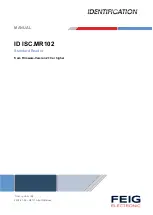
Page 4
SECTION I - GENERAL DESCRIPTION
1-1. GENERAL. SHAW-BOX Series “700” electric hoists are
wire rope and drum type hoists which are manufactured in two
basic models: A standard model, available in four conventional
suspensions (Lug Mounted, Push Trolley, Hand Geared Trolley
and Motor Driven Trolley); and, a low headroom model with
three special low-headroom design trolley suspensions (Push,
Hand Geared and Motor Driven types). The standard model
hoist comes in eleven load sizes, ranging from 2 thru 20 tons,
with various lifts and lifting speeds, while the low headroom
model comes in 7 load sizes, from 2 thru 10 tons, and various
lifts and lifting speeds. Both of the basic models are available
with single or two-speed lifting control. Deck mounted and base
mounted hoists are also available as modifications of the basic
hoist models. Deck mounted hoists are available thru 20 ton
rated load.
NOTICE
SHAW-BOX hoists thru 15 tons are available with an
optional built-in mechanical overload clutch. Hoists having
this device are identified with words “WEIGHT
WATCHER” on the hoist.
The “WEIGHT WATCHER” overload limiting device permits
operation of your hoist within its rated load and helps prevent
lifting of excessive loads which could cause permanent
deformation of a properly maintained hoist or trolley.
1-2. BASIC CONSTRUCTION. Series “700” standard model
and low headroom model electric hoists are of the same basic
construction, differing primarily in the suspension method and
rope reeving. They consist of a rugged steel frame which houses
a lifting drum and serves as the suspension for carrying the
entire hoist load. A mounting lug, for attaching the hoist trolley
or mounting to an overhead suspension (standard model), is
located on the top of the frame. An aluminum alloy gearcase,
attached to one end of the hoist frame, houses a two-reduction
gear train and a mechanical load brake. A gearcase cover and
a brake cover, both of aluminum alloy, mounted on the end of
the gearcase, houses an automatic motor brake. An electric
driving motor is mounted at the other end of the hoist frame.
Electrical system components, located in a compartment at
the front of the hoist frame, control operation and rotating
direction of driving motor. Hoisting cable and an enclosed lower
block assembly is used for lifting loads. An upper limit stop is
used to limit the travel of the lower block in the raising direction
to protect hoist from damage. A push button control station for
operating the hoist is suspended on a wire strain cable attached
to hoist frame at the motor end of the hoist.
SECTION II - INSTALLATION
2-1. GENERAL. SHAW-BOX Series 700" electric hoists are
lubricated and tested before being shipped from the factory. To
place hoist in service, attach a suitable suspension (Paragraph
2-2), connect to electrical service (Paragraph 2-3) and perform
pre-operation tests and checks (Paragraph 2-4).
Before attempting installation of hoist or trolley, the
main power switch must be locked in the open position
(off).
WARNING
Design and installation of hoist support shall be
performed only by qualified persons.
WARNING
2-2. SUSPENDING HOIST. Hoist may be suspended in a fixed
location servicing only the area directly below the hoist (Lug
Mounted). Hoist may be attached to a moveable trolley or
trolleys which in turn may be mounted on an I-beam attached
to a building or crane, servicing a large area (Trolley Mounted).
a. Lug Mounted hoists attach to adequate supports welded
or bolted to a building or other structure. The supporting
structure must have sufficient strength with appropriate
safety factor, to support the weight of the hoist and rated
load as well as other loads to which the supporting
structure may be subjected.
Steel angles or plates used to suspend hoist should be
spaced as close to the hoist suspension lug as possible.
Mounting bolts or threaded studs, attaching hoist to
mounting structure, shall have a diameter not less than
recommended by manufacturer and material equivalent
to ASTM A 325. Make certain that mounting bolts or
studs are long enough so that the threads do not engage
the mounting support and that mounting bolts or studs
are secured with nuts and lockwashers, selflocking nuts
or cross bolting, if unthreaded.
b. Trolley Mounted hoists are attached to moveable trolleys.
If hoist is mounted on an existing trolley, a qualified person
shall determine that the trolley and its supporting structure
are adequate to support the rated load and weight of the
hoist. Hoist/trolley units may be shipped from the factory
with trolley packaged separately. If the trolley can be
installed directly over the end of the supporting beam,
assemble trolley to hoist. Be certain that the spacing
between wheel flanges, after assembly, is 1/4" greater
than exact width of beam flange. (See Figure 2-1 below
and instruction sheet furnished with trolley.) Using proper
equipment, carefully lift trolley and hoist and install on
end of beam.
For trolleys which are to be mounted along the span of a
beam not having open ends, measure exact width of
beam flange and assemble trolley to hoist so that spacing
between wheel flanges is 1/4" (see Figure 2-1) greater
than beam width (3/8" if beam has curves). This is
accomplished by rearranging the spacer washers on the
bolts connecting trolley side plates to hoist mounting lug.
If trolley is shipped separate from hoist, see instruction
sheets furnished with trolley for orientation and installation.
Содержание SHAW-BOX
Страница 66: ...NOTES ...
Страница 67: ...NOTES ...





































